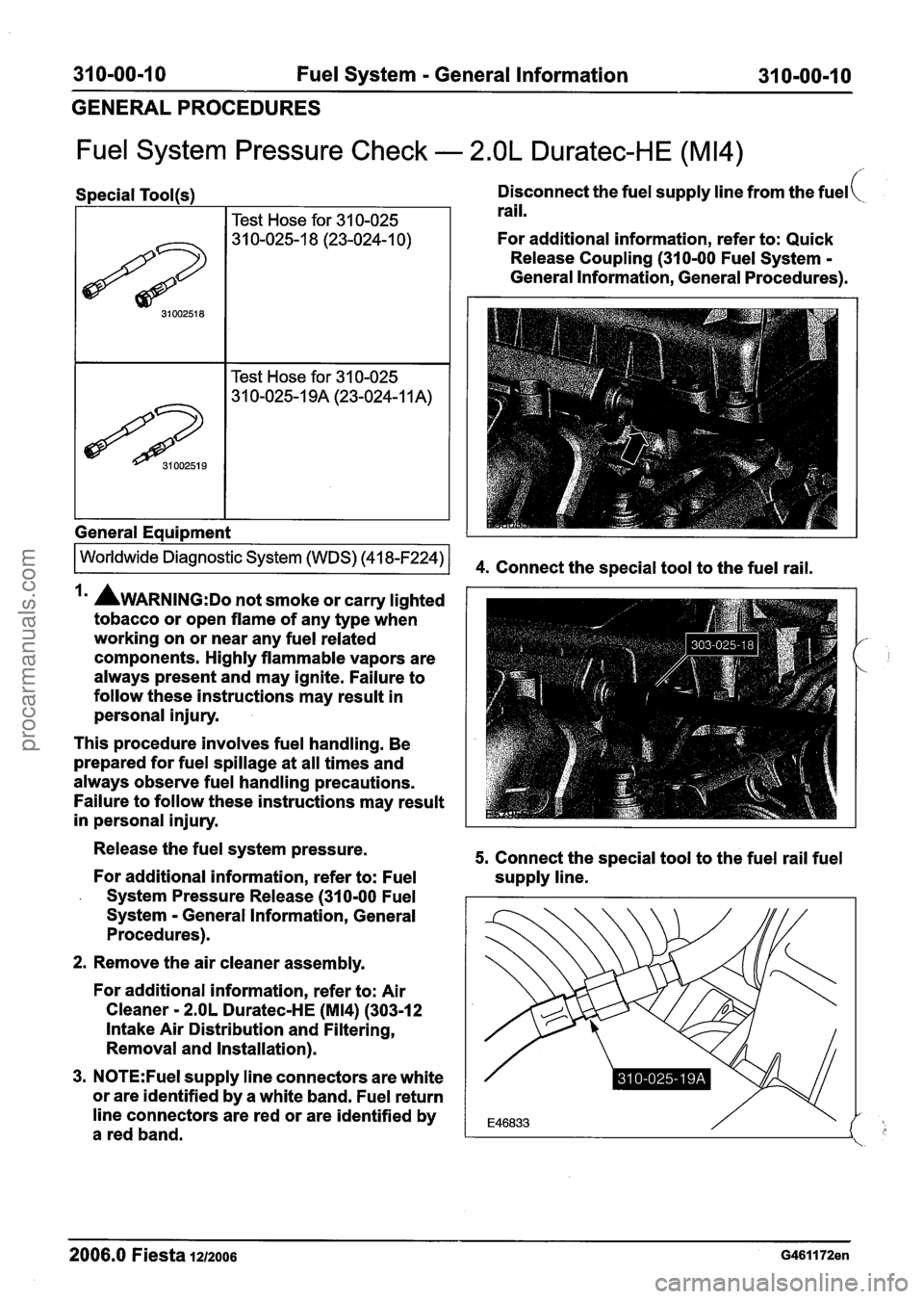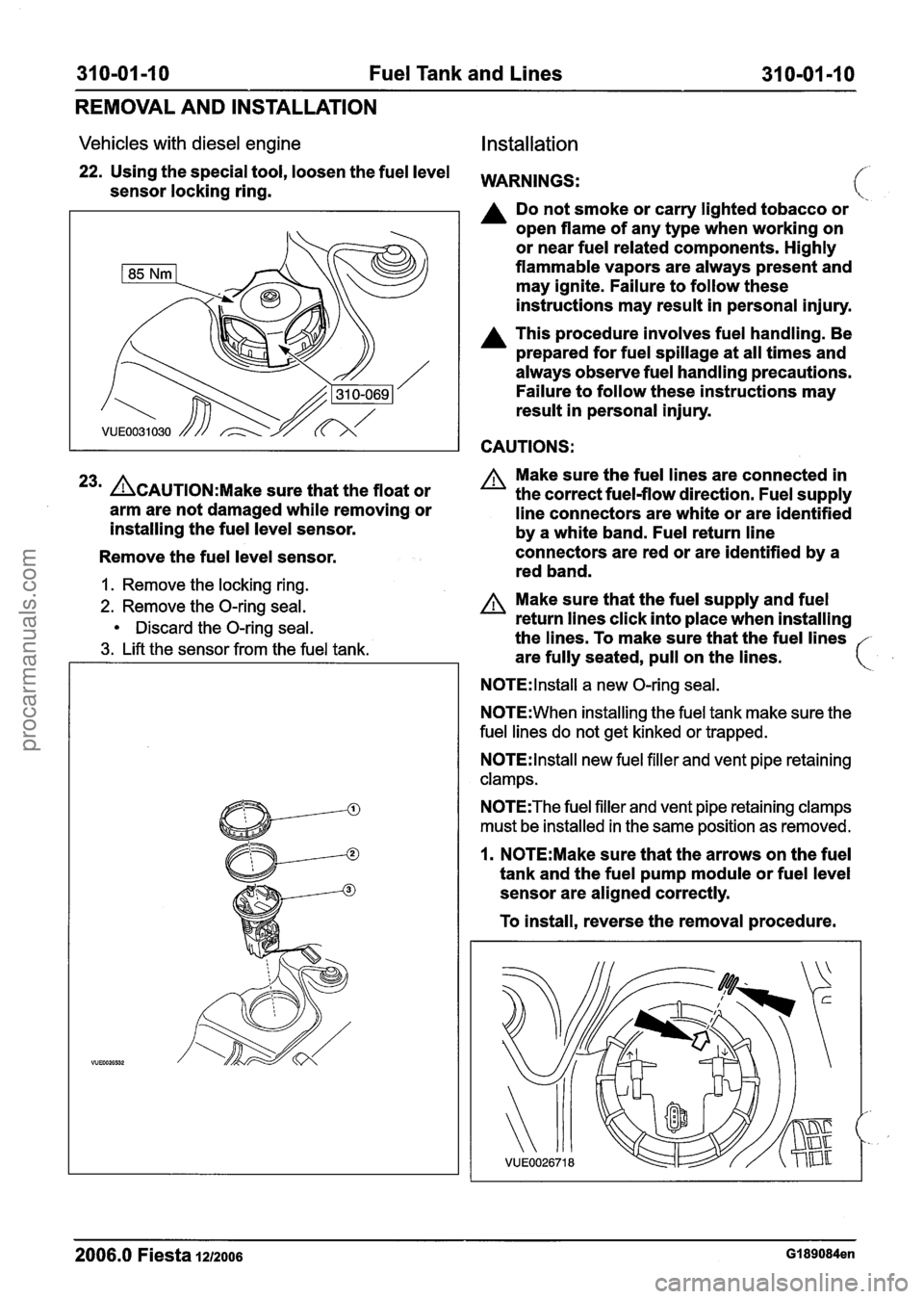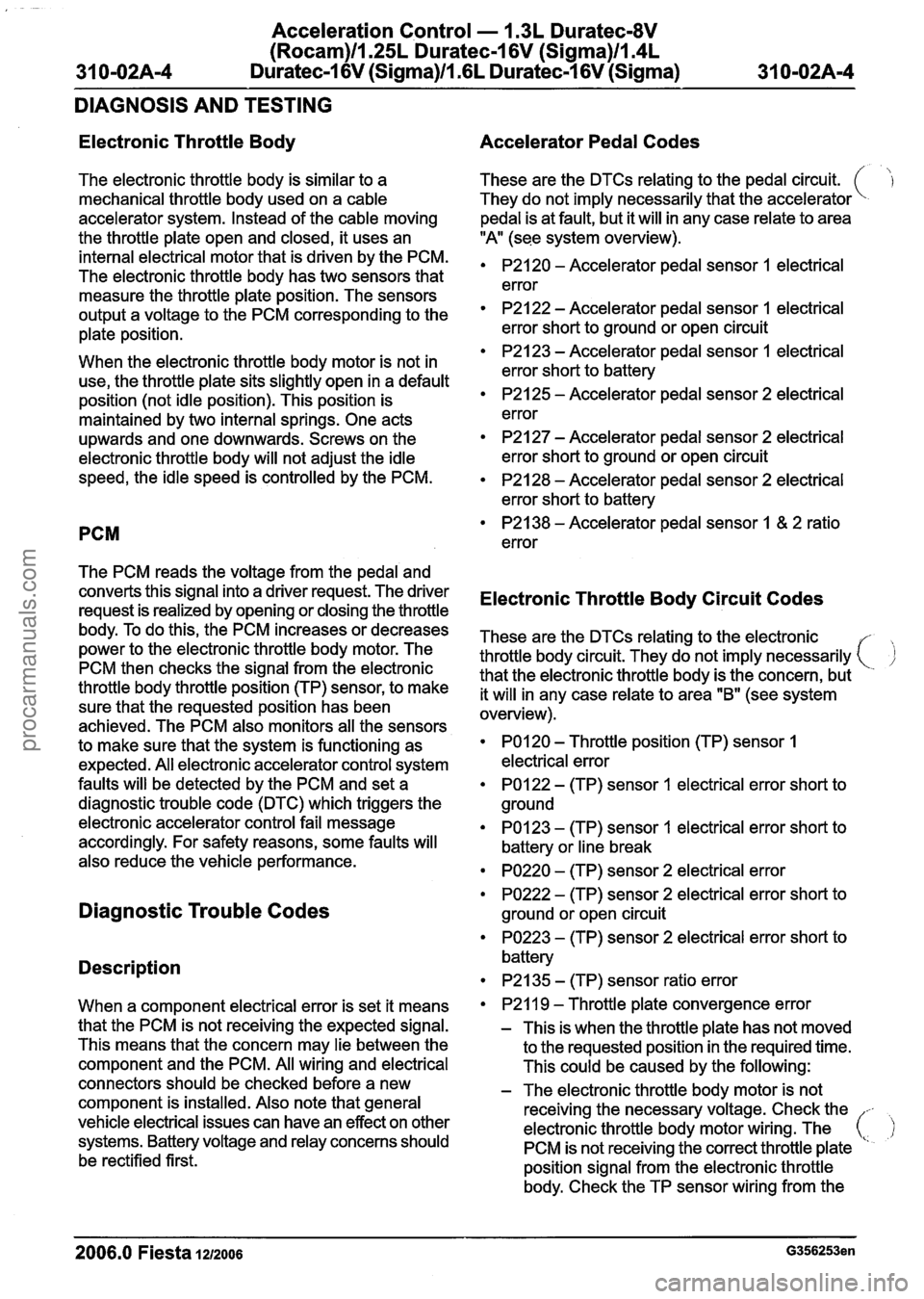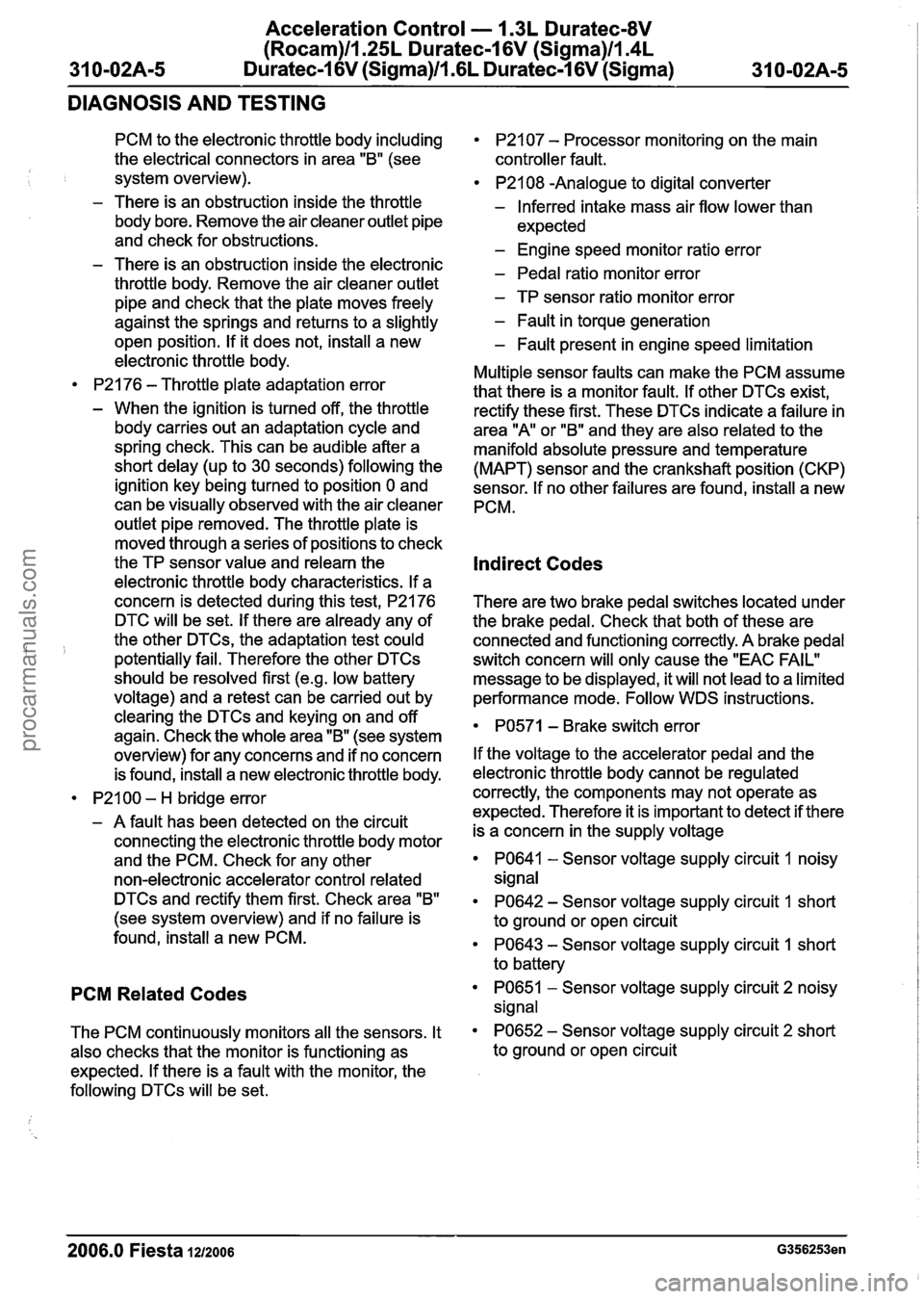2007 FORD FIESTA light
[x] Cancel search: lightPage 1196 of 1226

31 0-00-1 0 Fuel System - General Information 31 0-00-1 0
GENERALPROCEDURES
Fuel System Pressure Check - 2.OL Duratec-HE (M14)
Special Tool(s)
I Test Hose for 31 0-025
I I Test Hose for 31 0-025 1
General Equipment 1
Disconnect the fuel supply line from the fuel(
rail.
For additional information, refer to: Quick
Release Coupling (310-00 Fuel System
-
General Information, General Procedures).
Irn AWARNING:D~ not smoke or carry lighted
tobacco or open flame of any type when
working on or near any fuel related
components. Highly flammable vapors are
always present and may ignite. Failure to
follow these instructions may result in
personal injury.
This procedure involves fuel handling. Be
prepared for fuel spillage at all times and
always observe fuel handling precautions.
Failure to follow these instructions may result
in personal injury.
Release the fuel system pressure.
For additional information, refer to: Fuel
- System Pressure Release (310-00 Fuel
System
- General Information, General
Procedures).
2. Remove the air cleaner assembly.
For additional information, refer to: Air
Cleaner
- 2.OL Duratec-HE (M14) (303-12
Intake Air Distribution and Filtering,
Removal and Installation).
3.
N0TE:Fuel supply line connectors are white
or are identified by a white band. Fuel return
line connectors are red or are identified by
a red band.
5. Connect the special tool to the fuel rail fuel
supply line.
- - -- - - -
2006.0 Fiesta 1212006 G461172en
procarmanuals.com
Page 1204 of 1226

31 0-01 -6 Fuel Tank and Lines 31 0-01 -6
REMOVAL AND INSTALLATION
Fuel Tank(23 554 0)
Special Tool(s)
I I Wrench, Sender Unit, Fuel
General Equipment
I Transmission jack I
Removal
All vehicles
WARNINGS:
A Do not smoke or carry lighted tobacco or
open flame of any type when working on
or near fuel related components. Highly
flammable vapors are always present and
may ignite. Failure to follow these
instructions may result in personal injury.
A This procedure involves fuel handling. Be
prepared for fuel spillage at all times and
always observe fuel handling precautions.
Failure to follow these instructions may
4. Remove the floor panel crossmember. (
5. Detach the exhaust system from the center
exhaust hanger insulator.
result in personal injury.
I
1. Release the fuel system pressure. For 6. N0TE:When detaching the exhaust system
additional information, refer to
allow the system to be supported by the rear
Section
31 0-00 [Fuel System - General
suspension assembly.
Information].
. Detach the exhaust system from the rear 2. Drain the fuel tank. For additional
exhaust hanger insulator.
information, refer to Section
31 0-00 [Fuel
System
- General Information].
3. Raise and support the vehicle. For additional
information, refer to Section
100-02 [Jacking
and Lifting].
2006.0 Fiesta 1212006 GI 89084en
procarmanuals.com
Page 1208 of 1226

310-01 -1 0 Fuel Tank and Lines 31 0-01-10
REMOVAL AND INSTALLATION
Vehicles with diesel engine Installation
22. Using the special tool, loosen the fuel level WARNINGS: sensor locking ring.
A Do not smoke or carry lighted tobacco or
open flame of any type when working on
or near fuel related components. Highly
flammable vapors are always present and
may ignite. Failure to follow these
instructions may result in personal injury.
A This procedure involves fuel handling. Be
prepared for fuel spillage at all times and
always observe fuel handling precautions.
Failure to follow these instructions may
result in personal injury.
CAUTIONS:
23m &AUTION:M~~~ sure that the float or
arm are not damaged while removing or
installing the fuel level sensor.
Remove the fuel level sensor.
1. Remove the locking ring.
2. Remove the O-ring seal.
Discard the O-ring seal.
3. Lift the sensor from the fuel tank. Make
sure the fuel lines are connected in
the correct fuel-flow direction. Fuel supply
line connectors are white or are identified
by a white band. Fuel return line
connectors are red or are identified by a
red band.
A Make sure that the fuel supply and fuel
return lines click into place when installing
the lines. To make sure that the fuel lines
are fully seated, pull on the lines.
N0TE:lnstall a new O-ring seal.
N0TE:When installing the fuel tank make sure the
fuel lines do not get kinked or trapped.
N0TE:lnstall new fuel filler and vent pipe retaining
clamps.
N0TE:The fuel filler and vent pipe retaining clamps
must be installed in the same position as removed.
1. N0TE:Make sure that the arrows on the fuel
tank and the fuel pump module or fuel level
sensor are aligned correctly.
To install, reverse the removal procedure.
2006.0 Fiesta 1212006 GI 89084en
procarmanuals.com
Page 1210 of 1226

31 0-01 -1 2 Fuel Tank and Lines 31 0-01-12
REMOVAL AND INSTALLATION
Fuel Tank Filler Pipe(23 572 0)
Removal
WARNINGS:
A Do not smoke or carry lighted tobacco or
open flame of any type when working on
or near any fuel related components.
Highly flammable vapours are always
present and can ignite. Failure to follow
these instructions may result in personal
injury.
A This procedure involves fuel handling. Be
prepared for fuel spillage at all times and
always observe fuel handling precautions.
Failure to follow these instructions may
result in personal injury.
I. Disconnect the battery ground cable. For
additional information, refer to
Section
41 4-01 [Battery, Mounting and
Cables].
2. Drain the fuel tank. For additional
information, refer to Section
31 0-00 [Fuel
System
- General Information].
3. Raise and support the vehicle. For additional
information, refer to Section
100-02 [Jacking
and Lifting].
4. Remove the left-hand rear fender splash
shield (road wheel shown removed for
clarity).
5. Remove the fuel tank filler pipe upper (.
retaining bolt.
'' &AUTION:W~~~ disconnecting the fuel
tank vent and fuel tank filler pipes, do not
use any sharp edge tools to lever off the
pipes. Failure to follow this instructions may
cause damage to the pipes.
N0TE:Make note of the positions of the retaining
clamps to make sure they are positioned in exactly
the same positions when installing.
Disconnect the fuel tank filler pipe and the
fuel tank vent pipe from the fuel tank.
Discard the retaining clamps.
2006.0 Fiesta 1212006 G210057en
procarmanuals.com
Page 1211 of 1226

31 0-01 -1 3 Fuel Tank and Lines 31 0-01 -1 3
REMOVAL AND INSTALLATION
7. Remove the fuel tank filler pipe lower
retaining bolt and remove the fuel tank filler
i pipe.
Installation
WARNINGS:
A Do not smoke or carry lighted tobacco or
open flame of any type when working on
or near any fuel related components.
Highly flammable vapours are always
present and can ignite. Failure to follow
these instructions may result in personal
' injury.
A This procedure involves fuel handling. Be
prepared for fuel spillage at all times and
always observe fuel handling precautions.
Failure to follow these instructions may
result in personal injury.
N0TE:lnstall new fuel tank filler pipe and vent pipe
retaining clamps.
N0TE:The fuel tank filler pipe and vent pipe
retaining clamps must be installed in the same
position as removed.
1. To install, reverse the removal procedure.
2006.0 Fiesta 1212006 G210057en
procarmanuals.com
Page 1216 of 1226

Acceleration Control - 1.3L Duratec-8V
(Rocam)ll.25L Duratec-1 6V (Sigma)ll.4L
Duratec-I 6V (Sigma)/l16L Duratec-1 6V (Sigma)
DESCRIPTION AND OPERATION
Acceleration Control
I .3L Duratec 8V
Item Description
I 1 I Accelerator cable
1 2 IThrottle body I
The throttle is cable operated on the 1.3L Duratec
8V engine.
There are two different throttle bodies, depending
on the power of the variant.
Because the throttle flap opening angle is different,
the way in which the cable is controlled at the
throttle flap varies slightly between the two different
variants.
I .4L/1.6L Duratec 16V
The 1.4Ll1.6L Duratec 16V engines have an
electronically controlled throttle flap control unit.
For information on the electronically controlled
throttle flap control unit, please refer to Section
303-1 4.
2006.0 Fiesta 1212006 G281370en
procarmanuals.com
Page 1218 of 1226

Acceleration Control - 1.3L Duratec-8V
(Rocam)llI25L Duratec-1 6V (Sigma)llI4L
31 0-02A-4 Duratec-1 6V (Sigma)/l .6L
Duratec-1 6V (Sigma)
31 0-02A-4
DIAGNOSIS AND TESTING
Electronic Throttle Body
The electronic throttle body is similar to a
mechanical throttle body used on a cable
accelerator system. Instead of the cable moving
the throttle plate open and closed, it uses an
internal electrical motor that is driven by the PCM.
The electronic throttle body has two sensors that
measure the throttle plate position. The sensors
output a voltage to the PCM corresponding to the
plate position.
When the electronic throttle body motor is not in
use, the throttle plate sits slightly open in a default
position (not idle position). This position is
maintained by two internal springs. One acts
upwards and one downwards. Screws on the
electronic throttle body will not adjust the idle
speed, the idle speed is controlled by the PCM.
PCM
The PCM reads the voltage from the pedal and
converts this signal into a driver request. The driver
request is realized by opening or closing the throttle
body. To do this, the PCM increases or decreases
power to the electronic throttle body motor. The
PCM then checks the signal from the electronic
throttle body throttle position (TP) sensor, to make
sure that the requested position has been
achieved. The PCM also monitors all the sensors
to make sure that the system is functioning as
expected. All electronic accelerator control system
faults will be detected by the PCM and set a
diagnostic trouble code (DTC) which triggers the
electronic accelerator control fail message
accordingly. For safety reasons, some faults will
also reduce the vehicle performance.
Diagnostic Trouble Codes
Description
When a component electrical error is set it means
that the PCM is not receiving the expected signal.
This means that the concern may lie between the
component and the PCM. All wiring and electrical
connectors should be checked before a new
component is installed. Also note that general
vehicle electrical issues can have an effect on other
systems. Battery voltage and relay concerns should
be rectified first.
Accelerator Pedal Codes
These are the DTCs relating to the pedal circuit.
They do not imply necessarily that the accelerator
pedal is at fault, but it will in any case relate to area
"A (see system overview).
P2120 - Accelerator pedal sensor 1 electrical
error
P2122 - Accelerator pedal sensor I electrical
error short to ground or open circuit
P2123 - Accelerator pedal sensor I electrical
error short to battery
P2125 - Accelerator pedal sensor 2 electrical
error
P2127 - Accelerator pedal sensor 2 electrical
error short to ground or open circuit
P2128 - Accelerator pedal sensor 2 electrical
error short to battery
P2138 - Accelerator pedal sensor 1 & 2 ratio
error
Electronic Throttle Body Circuit Codes
These are the DTCs relating to the electronic
throttle body circuit. They do not imply necessarily
( ,)
that the electronic throttle body is the concern, but
it will in any case relate to area "B" (see system
overview).
PO1 20 - Throttle position (TP) sensor 1
electrical error
PO122 - (TP) sensor 1 electrical error short to
ground
PO123 - (TP) sensor 1 electrical error short to
battery or line break
PO220 - (TP) sensor 2 electrical error
PO222 - (TP) sensor 2 electrical error short to
ground or open circuit
PO223 - (TP) sensor 2 electrical error short to
battery
P2135 - (TP) sensor ratio error
P21
I 9 - Throttle plate convergence error
- This is when the throttle plate has not moved
to the requested position in the required time.
This could be caused by the following:
- The electronic throttle body motor is not
receiving the necessary voltage. Check the
--
electronic throttle body motor wiring. The ( PCM is not receiving the correct throttle plate '
position signal from the electronic throttle
body. Check the TP sensor wiring from the
2006.0 Fiesta 1212006 G356253en
procarmanuals.com
Page 1219 of 1226

Acceleration Control - 1.3L Duratec-8V
(Rocam)ll.25L Duratec-1 6V (Sigma)ll.4L
31 0-02A-5 Duratec-1 6V (Sigma)/l .6L Duratec-1 6V (Sigma)
31 0-02A-5
DIAGNOSIS AND TESTING
PCM to the electronic throttle body including
the electrical connectors in area "B" (see
system overview).
- There is an obstruction inside the throttle
body bore. Remove the air cleaner outlet pipe
and check for obstructions.
- There is an obstruction inside the electronic
throttle body. Remove the air cleaner outlet
pipe and check that the plate moves freely
against the springs and returns to a slightly
open position. If it does not, install a new
electronic throttle body.
P2176 - Throttle plate adaptation error
- When the ignition is turned off, the throttle
body carries out an adaptation cycle and
spring check. This can be audible after a
short delay (up to 30 seconds) following the ignition key being turned to position
0 and
can be visually observed with the air cleaner
outlet pipe removed. The throttle plate is
moved through a series of positions to check
the TP sensor value and relearn the
electronic throttle body characteristics. If a
concern is detected during this test,
P2176
DTC will be set. If there are already any of
I the other DTCs, the adaptation test could
potentially fail. Therefore the other DTCs
should be resolved first
(e.g. low battery
voltage) and a retest can be carried out by
clearing the DTCs and keying on and off
again. Check the whole area "B" (see system
overview) for any concerns and if no concern
is found, install a new electronic throttle body.
P2100 - H bridge error
- A fault has been detected on the circuit
connecting the electronic throttle body motor
and the PCM. Check for any other
non-electronic accelerator control related
DTCs and rectify them first. Check area "B"
(see system overview) and if no failure is
found, install a new PCM.
PCM Related Codes
The PCM continuously monitors all the sensors. It
also checks that the monitor is functioning as
expected. If there is a fault with the monitor, the
following DTCs will be set.
P2107 - Processor monitoring on the main
controller fault.
P2108 -Analogue to digital converter
- Inferred intake mass air flow lower than
expected
- Engine speed monitor ratio error
- Pedal ratio monitor error
- TP sensor ratio monitor error
- Fault in torque generation
- Fault present in engine speed limitation
Multiple sensor faults can make the PCM assume
that there is a monitor fault. If other DTCs exist,
rectify these first. These DTCs indicate a failure in
area
"A or "B" and they are also related to the
manifold absolute pressure and temperature
(MAPT) sensor and the crankshaft position (CKP)
sensor. If no other failures are found, install a new
PCM.
Indirect Codes
There are two brake pedal switches located under
the brake pedal. Check that both of these are
connected and functioning correctly. A brake pedal
switch concern will only cause the "EAC FAIL"
message to be displayed, it will not lead to a limited
performance mode. Follow WDS instructions.
PO571 - Brake switch error
If the voltage to the accelerator pedal and the
electronic throttle body cannot be regulated
correctly, the components may not operate as
expected. Therefore it is important to detect if there
is a concern in the supply voltage
PO641 - Sensor voltage supply circuit I noisy
signal
PO642 - Sensor voltage supply circuit 1 short
to ground or open circuit
PO643 - Sensor voltage supply circuit 1 short
to battery
PO651 - Sensor voltage supply circuit 2 noisy
signal
PO652 - Sensor voltage supply circuit 2 short
to ground or open circuit
2006.0 Fiesta 1212006 G356253en
procarmanuals.com